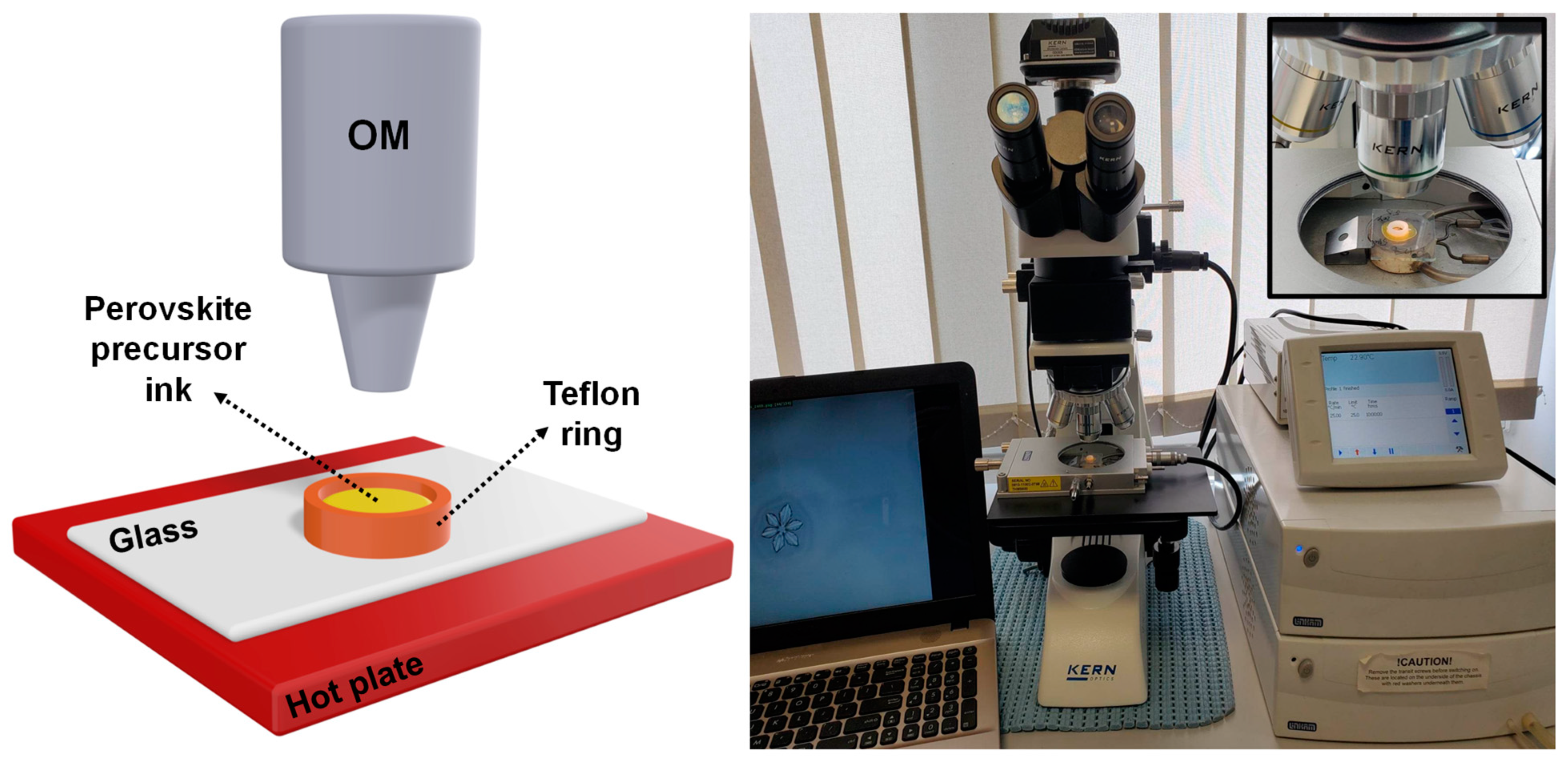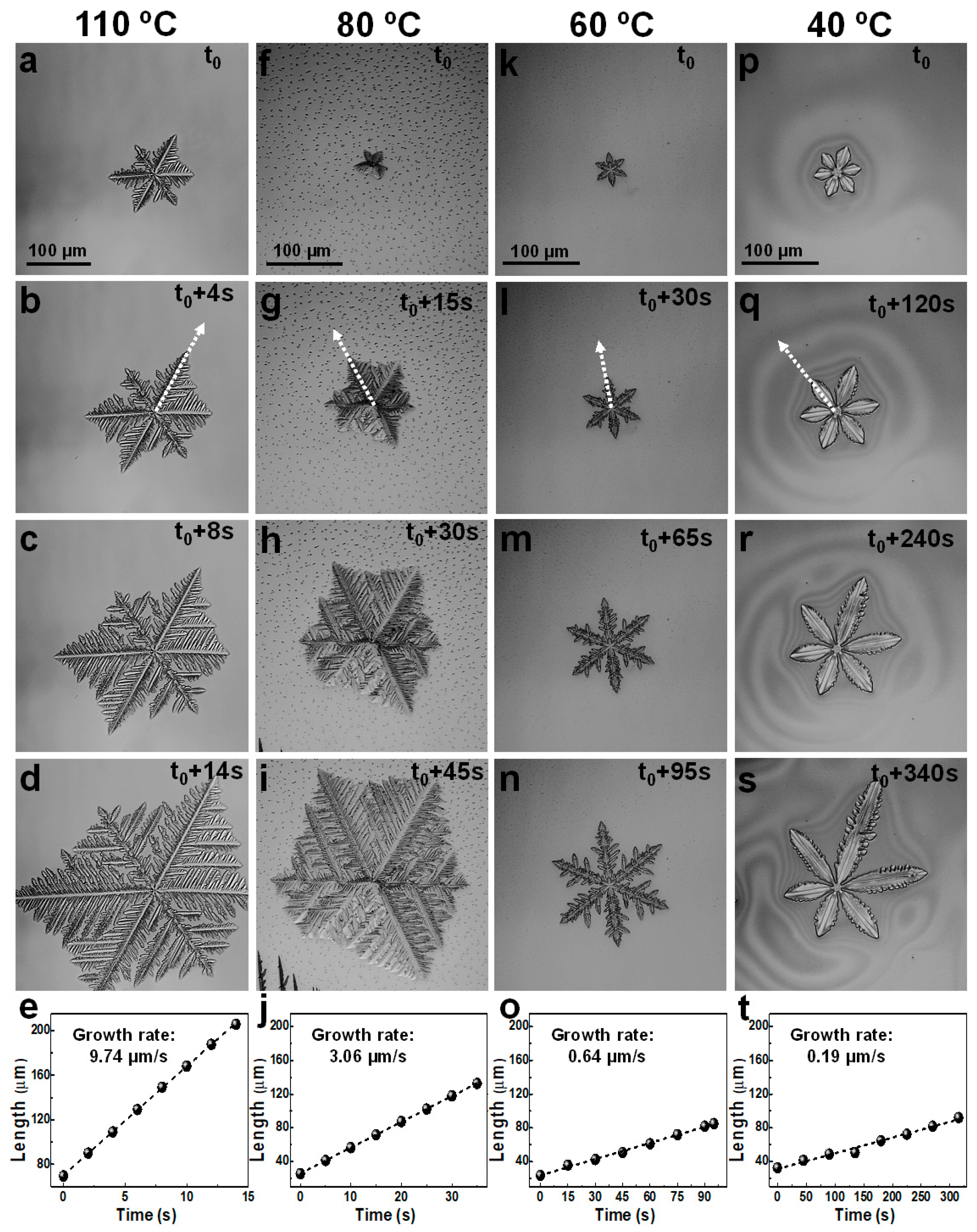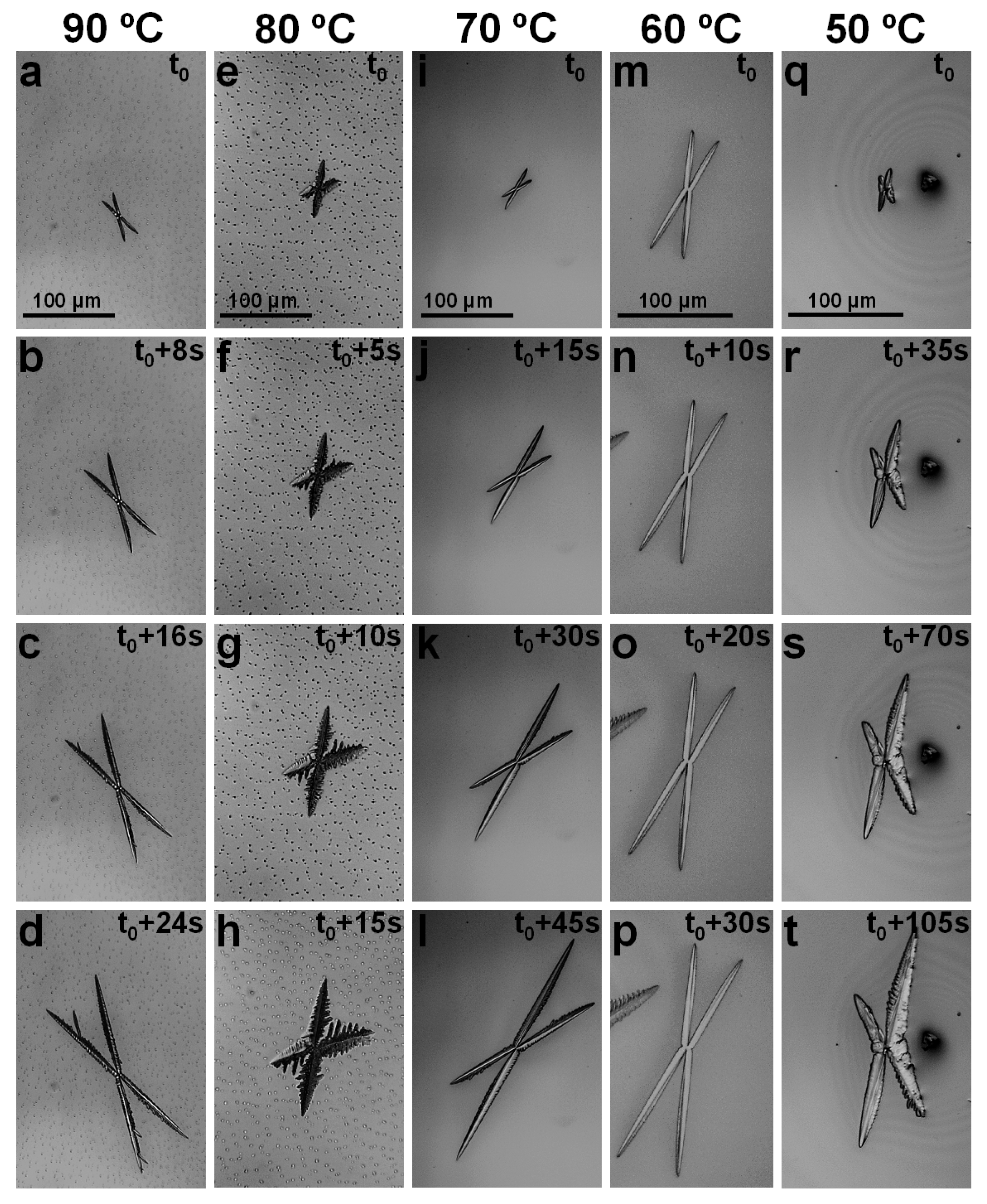Growth of Hybrid Perovskite Crystals from CH3NH3PbI3–xClx Solutions Subjected to Constant Solvent Evaporation Rates
Abstract
:1. Introduction
2. Materials and Methods
3. Results and Discussion
4. Conclusions
Author Contributions
Funding
Institutional Review Board Statement
Informed Consent Statement
Data Availability Statement
Conflicts of Interest
References
- Min, H.; Lee, D.Y.; Kim, J.; Kim, G.; Lee, K.S.; Kim, J.; Paik, M.J.; Kim, Y.K.; Kim, K.S.; Kim, M.G.; et al. Perovskite Solar Cells with Atomically Coherent Interlayers on SnO2 Electrodes. Nature 2021, 598, 444–450. [Google Scholar] [CrossRef] [PubMed]
- Xiong, Z.; Chen, X.; Zhang, B.; Odunmbaku, G.O.; Ou, Z.; Guo, B.; Yang, K.; Kan, Z.; Lu, S.; Chen, S.; et al. Simultaneous Interfacial Modification and Crystallization Control by Biguanide Hydrochloride for Stable Perovskite Solar Cells with PCE of 24.4%. Adv. Mater. 2022, 34, 2106118. [Google Scholar] [CrossRef] [PubMed]
- Sharma, R.; Sharma, A.; Agarwal, S.; Dhaka, M.S. Stability and Efficiency Issues, Solutions and Advancements in Perovskite Solar Cells: A Review. Sol. Energy 2022, 244, 516–535. [Google Scholar] [CrossRef]
- Lee, D.-K.; Park, N.-G. Materials and Methods for High-Efficiency Perovskite Solar Modules. Sol. RRL 2022, 6, 2100455. [Google Scholar] [CrossRef]
- Guo, Z.; Zhang, Y.; Wang, B.; Wang, L.; Zhou, N.; Qiu, Z.; Li, N.; Chen, Y.; Zhu, C.; Xie, H.; et al. Promoting Energy Transfer via Manipulation of Crystallization Kinetics of Quasi-2D Perovskites for Efficient Green Light-Emitting Diodes. Adv. Mater. 2021, 33, 2102246. [Google Scholar] [CrossRef]
- Ai, B.; Fan, Z.; Wong, Z.J. Plasmonic–Perovskite Solar Cells, Light Emitters, and Sensors. Microsyst. Nanoeng. 2022, 8, 5. [Google Scholar] [CrossRef] [PubMed]
- Rakshit, S.; Piatkowski, P.; Mora-Seró, I.; Douhal, A. Combining Perovskites and Quantum Dots: Synthesis, Characterization, and Applications in Solar Cells, LEDs, and Photodetectors. Adv. Opt. Mater. 2022, 10, 2102566. [Google Scholar] [CrossRef]
- Xiao, M.; Huang, F.; Huang, W.; Dkhissi, Y.; Zhu, Y.; Etheridge, J.; Gray-Weale, A.; Bach, U.; Cheng, Y.-B.; Spiccia, L. A Fast Deposition-Crystallization Procedure for Highly Efficient Lead Iodide Perovskite Thin-Film Solar Cells. Angew. Chem. Int. Ed. 2014, 53, 9898–9903. [Google Scholar] [CrossRef]
- Liu, X.; Tan, X.; Liu, Z.; Ye, H.; Sun, B.; Shi, T.; Tang, Z.; Liao, G. Boosting the Efficiency of Carbon-Based Planar CsPbBr3 Perovskite Solar Cells by a Modified Multistep Spin-Coating Technique and Interface Engineering. Nano Energy 2019, 56, 184–195. [Google Scholar] [CrossRef]
- Zuo, C.; Ding, L. Drop-Casting to Make Efficient Perovskite Solar Cells under High Humidity. Angew. Chem. Int. Ed. 2021, 60, 11242–11246. [Google Scholar] [CrossRef] [PubMed]
- Zuo, C.; Scully, A.D.; Gao, M. Drop-Casting Method to Screen Ruddlesden–Popper Perovskite Formulations for Use in Solar Cells. ACS Appl. Mater. Interfaces 2021, 13, 56217–56225. [Google Scholar] [CrossRef]
- Zuo, C.; Scully, A.D.; Tan, W.L.; Zheng, F.; Ghiggino, K.P.; Vak, D.; Weerasinghe, H.; McNeill, C.R.; Angmo, D.; Chesman, A.S.R.; et al. Crystallisation Control of Drop-Cast Quasi-2D/3D Perovskite Layers for Efficient Solar Cells. Commun. Mater. 2020, 1, 33. [Google Scholar] [CrossRef]
- Adnan, M.; Lee, J.K. All Sequential Dip-Coating Processed Perovskite Layers from an Aqueous Lead Precursor for High Efficiency Perovskite Solar Cells. Sci. Rep. 2018, 8, 2168. [Google Scholar] [CrossRef] [PubMed] [Green Version]
- Adnan, M.; Irshad, Z.; Lee, J.K. Facile All-Dip-Coating Deposition of Highly Efficient (CH3)3NPbI3−xClx Perovskite Materials from Aqueous Non-Halide Lead Precursor. RSC Adv. 2020, 10, 29010–29017. [Google Scholar] [CrossRef] [PubMed]
- Irshad, Z.; Adnan, M.; Lee, J.K. Simple Preparation of Highly Efficient MAxFA1−xPbI3 Perovskite Films from an Aqueous Halide-Free Lead Precursor by All Dip-Coating Approach and Application in High-Performance Perovskite Solar Cells. J. Mater. Sci. 2022, 57, 1936–1946. [Google Scholar] [CrossRef]
- Barrows, A.T.; Pearson, A.J.; Kwak, C.K.; Dunbar, A.D.F.; Buckley, A.R.; Lidzey, D.G. Efficient Planar Heterojunction Mixed-Halide Perovskite Solar Cells Deposited via Spray-Deposition. Energy Environ. Sci. 2014, 7, 2944–2950. [Google Scholar] [CrossRef]
- Bishop, J.E.; Smith, J.A.; Lidzey, D.G. Development of Spray-Coated Perovskite Solar Cells. ACS Appl. Mater. Interfaces 2020, 12, 48237–48245. [Google Scholar] [CrossRef]
- Das, S.; Yang, B.; Gu, G.; Joshi, P.C.; Ivanov, I.N.; Rouleau, C.M.; Aytug, T.; Geohegan, D.B.; Xiao, K. High-Performance Flexible Perovskite Solar Cells by Using a Combination of Ultrasonic Spray-Coating and Low Thermal Budget Photonic Curing. ACS Photonics 2015, 2, 680–686. [Google Scholar] [CrossRef]
- Schmidt, T.M.; Larsen-Olsen, T.T.; Carlé, J.E.; Angmo, D.; Krebs, F.C. Upscaling of Perovskite Solar Cells: Fully Ambient Roll Processing of Flexible Perovskite Solar Cells with Printed Back Electrodes. Adv. Energy Mater. 2015, 5, 1500569. [Google Scholar] [CrossRef]
- Yang, Z.; Chueh, C.-C.; Zuo, F.; Kim, J.H.; Liang, P.-W.; Jen, A.K.-Y. High-Performance Fully Printable Perovskite Solar Cells via Blade-Coating Technique under the Ambient Condition. Adv. Energy Mater. 2015, 5, 1500328. [Google Scholar] [CrossRef]
- Kim, J.H.; Williams, S.T.; Cho, N.; Chueh, C.-C.; Jen, A.K.-Y. Enhanced Environmental Stability of Planar Heterojunction Perovskite Solar Cells Based on Blade-Coating. Adv. Energy Mater. 2015, 5, 1401229. [Google Scholar] [CrossRef]
- Yang, J.; Lim, E.L.; Tan, L.; Wei, Z. Ink Engineering in Blade-Coating Large-Area Perovskite Solar Cells. Adv. Energy Mater. 2022, 12, 2200975. [Google Scholar] [CrossRef]
- Jeong, D.-N.; Lee, D.-K.; Seo, S.; Lim, S.Y.; Zhang, Y.; Shin, H.; Cheong, H.; Park, N.-G. Perovskite Cluster-Containing Solution for Scalable D-Bar Coating toward High-Throughput Perovskite Solar Cells. ACS Energy Lett. 2019, 4, 1189–1195. [Google Scholar] [CrossRef]
- Lim, K.-S.; Lee, D.-K.; Lee, J.-W.; Park, N.-G. 17% Efficient Perovskite Solar Mini-Module via Hexamethylphosphoramide (HMPA)-Adduct-Based Large-Area D-Bar Coating. J. Mater. Chem. A 2020, 8, 9345–9354. [Google Scholar] [CrossRef]
- Troughton, J.; Bryant, D.; Wojciechowski, K.; Carnie, M.J.; Snaith, H.; Worsley, D.A.; Watson, T.M. Highly Efficient, Flexible, Indium-Free Perovskite Solar Cells Employing Metallic Substrates. J. Mater. Chem. A 2015, 3, 9141–9145. [Google Scholar] [CrossRef]
- Liu, C.; Cheng, Y.-B.; Ge, Z. Understanding of Perovskite Crystal Growth and Film Formation in Scalable Deposition Processes. Chem. Soc. Rev. 2020, 49, 1653–1687. [Google Scholar] [CrossRef]
- Chen, W.; Li, X.; Li, Y.; Li, Y. A Review: Crystal Growth for High-Performance All-Inorganic Perovskite Solar Cells. Energy Environ. Sci. 2020, 13, 1971–1996. [Google Scholar] [CrossRef]
- Xiao, Z.; Dong, Q.; Bi, C.; Shao, Y.; Yuan, Y.; Huang, J. Solvent Annealing of Perovskite-Induced Crystal Growth for Photovoltaic-Device Efficiency Enhancement. Adv. Mater. 2014, 26, 6503–6509. [Google Scholar] [CrossRef]
- Du, P.; Wang, L.; Li, J.; Luo, J.; Ma, Y.; Tang, J.; Zhai, T. Thermal Evaporation for Halide Perovskite Optoelectronics: Fundamentals, Progress, and Outlook. Adv. Opt. Mater. 2022, 10, 2101770. [Google Scholar] [CrossRef]
- Sánchez, S.; Vallés-Pelarda, M.; Alberola-Borràs, J.-A.; Vidal, R.; Jerónimo-Rendón, J.J.; Saliba, M.; Boix, P.P.; Mora-Seró, I. Flash Infrared Annealing as a Cost-Effective and Low Environmental Impact Processing Method for Planar Perovskite Solar Cells. Mater. Today 2019, 31, 39–46. [Google Scholar] [CrossRef]
- Li, X.; Bi, D.; Yi, C.; Décoppet, J.-D.; Luo, J.; Zakeeruddin, S.M.; Hagfeldt, A.; Grätzel, M. A Vacuum Flash–Assisted Solution Process for High-Efficiency Large-Area Perovskite Solar Cells. Science 2016, 353, 58–62. [Google Scholar] [CrossRef] [PubMed]
- Wu, G.; Li, X.; Zhou, J.; Zhang, J.; Zhang, X.; Leng, X.; Wang, P.; Chen, M.; Zhang, D.; Zhao, K.; et al. Fine Multi-Phase Alignments in 2D Perovskite Solar Cells with Efficiency over 17% via Slow Post-Annealing. Adv. Mater. 2019, 31, 1903889. [Google Scholar] [CrossRef] [PubMed]
- Cheng, X.; Yang, S.; Cao, B.; Tao, X.; Chen, Z. Single Crystal Perovskite Solar Cells: Development and Perspectives. Adv. Funct. Mater. 2020, 30, 1905021. [Google Scholar] [CrossRef]
- Zuo, T.; He, X.; Hu, P.; Jiang, H. Organic-Inorganic Hybrid Perovskite Single Crystals: Crystallization, Molecular Structures, and Bandgap Engineering. ChemNanoMat 2019, 5, 278–289. [Google Scholar] [CrossRef]
- Singh, R.; Parashar, M.; Sandhu, S.; Yoo, K.; Lee, J.-J. The Effects of Crystal Structure on the Photovoltaic Performance of Perovskite Solar Cells under Ambient Indoor Illumination. Sol. Energy 2021, 220, 43–50. [Google Scholar] [CrossRef]
- Cho, Y.; Jung, H.R.; Jo, W. Halide Perovskite Single Crystals: Growth, Characterization, and Stability for Optoelectronic Applications. Nanoscale 2022, 14, 9248–9277. [Google Scholar] [CrossRef]
- Xu, J.; Ma, J.; Gu, Y.; Li, Y.; Li, Y.; Shen, H.; Zhang, Z.; Ma, Y. Progress of Metal Halide Perovskite Crystals From a Crystal Growth Point of View. Cryst. Res. Technol. 2023, 58, 2200128. [Google Scholar] [CrossRef]
- Haque, M.A.; Troughton, J.; Baran, D. Processing-Performance Evolution of Perovskite Solar Cells: From Large Grain Polycrystalline Films to Single Crystals. Adv. Energy Mater. 2020, 10, 1902762. [Google Scholar] [CrossRef]
- Gao, Q.; Qi, J.; Chen, K.; Xia, M.; Hu, Y.; Mei, A.; Han, H. Halide Perovskite Crystallization Processes and Methods in Nanocrystals, Single Crystals, and Thin Films. Adv. Mater. 2022, 34, 2200720. [Google Scholar] [CrossRef]
- Peng, W.; Wang, L.; Murali, B.; Ho, K.-T.; Bera, A.; Cho, N.; Kang, C.-F.; Burlakov, V.M.; Pan, J.; Sinatra, L.; et al. Solution-Grown Monocrystalline Hybrid Perovskite Films for Hole-Transporter-Free Solar Cells. Adv. Mater. 2016, 28, 3383–3390. [Google Scholar] [CrossRef] [Green Version]
- Liu, Y.; Zhang, Y.; Yang, Z.; Yang, D.; Ren, X.; Pang, L.; Liu, S. Thinness- and Shape-Controlled Growth for Ultrathin Single-Crystalline Perovskite Wafers for Mass Production of Superior Photoelectronic Devices. Adv. Mater. 2016, 28, 9204–9209. [Google Scholar] [CrossRef] [PubMed]
- Chen, J.; Morrow, D.J.; Fu, Y.; Zheng, W.; Zhao, Y.; Dang, L.; Stolt, M.J.; Kohler, D.D.; Wang, X.; Czech, K.J.; et al. Single-Crystal Thin Films of Cesium Lead Bromide Perovskite Epitaxially Grown on Metal Oxide Perovskite (SrTiO3). J. Am. Chem. Soc. 2017, 139, 13525–13532. [Google Scholar] [CrossRef] [Green Version]
- Zhumekenov, A.A.; Burlakov, V.M.; Saidaminov, M.I.; Alofi, A.; Haque, M.A.; Turedi, B.; Davaasuren, B.; Dursun, I.; Cho, N.; El-Zohry, A.M.; et al. The Role of Surface Tension in the Crystallization of Metal Halide Perovskites. ACS Energy Lett. 2017, 2, 1782–1788. [Google Scholar] [CrossRef] [Green Version]
- Poglitsch, A.; Weber, D. Dynamic Disorder in Methylammoniumtrihalogenoplumbates (II) Observed by Millimeter-wave Spectroscopy. J. Chem. Phys. 1987, 87, 6373–6378. [Google Scholar] [CrossRef]
- Liu, Y.; Yang, Z.; Cui, D.; Ren, X.; Sun, J.; Liu, X.; Zhang, J.; Wei, Q.; Fan, H.; Yu, F.; et al. Two-Inch-Sized Perovskite CH3NH3PbX3 (X = Cl, Br, I) Crystals: Growth and Characterization. Adv. Mater. 2015, 27, 5176–5183. [Google Scholar] [CrossRef] [PubMed]
- Saidaminov, M.I.; Abdelhady, A.L.; Murali, B.; Alarousu, E.; Burlakov, V.M.; Peng, W.; Dursun, I.; Wang, L.; He, Y.; Maculan, G.; et al. High-Quality Bulk Hybrid Perovskite Single Crystals within Minutes by Inverse Temperature Crystallization. Nat. Commun. 2015, 6, 7586. [Google Scholar] [CrossRef] [Green Version]
- Saidaminov, M.I.; Abdelhady, A.L.; Maculan, G.; Bakr, O.M. Retrograde Solubility of Formamidinium and Methylammonium Lead Halide Perovskites Enabling Rapid Single Crystal Growth. Chem. Commun. 2015, 51, 17658–17661. [Google Scholar] [CrossRef] [Green Version]
- Gupta, R.; Korukonda, T.B.; Gupta, S.K.; Dhamaniya, B.P.; Chhillar, P.; Datt, R.; Vashishtha, P.; Gupta, G.; Gupta, V.; Srivastava, R.; et al. Room Temperature Synthesis of Perovskite (MAPbI3) Single Crystal by Anti-Solvent Assisted Inverse Temperature Crystallization Method. J. Cryst. Growth 2020, 537, 125598. [Google Scholar] [CrossRef]
- He, M.; Li, B.; Cui, X.; Jiang, B.; He, Y.; Chen, Y.; O’Neil, D.; Szymanski, P.; EI-Sayed, M.A.; Huang, J.; et al. Meniscus-Assisted Solution Printing of Large-Grained Perovskite Films for High-Efficiency Solar Cells. Nat. Commun. 2017, 8, 16045. [Google Scholar] [CrossRef]
- Dang, Y.; Ju, D.; Wang, L.; Tao, X. Recent Progress in the Synthesis of Hybrid Halide Perovskite Single Crystals. CrystEngComm 2016, 18, 4476–4484. [Google Scholar] [CrossRef]
- Wei, H.; Fang, Y.; Mulligan, P.; Chuirazzi, W.; Fang, H.-H.; Wang, C.; Ecker, B.R.; Gao, Y.; Loi, M.A.; Cao, L.; et al. Sensitive X-Ray Detectors Made of Methylammonium Lead Tribromide Perovskite Single Crystals. Nat. Photonics 2016, 10, 333–339. [Google Scholar] [CrossRef]
- Sun, J.; Li, F.; Yuan, J.; Ma, W. Advances in Metal Halide Perovskite Film Preparation: The Role of Anti-Solvent Treatment. Small Methods 2021, 5, 2100046. [Google Scholar] [CrossRef] [PubMed]
- Ray, A.; Martín-García, B.; Moliterni, A.; Casati, N.; Boopathi, K.M.; Spirito, D.; Goldoni, L.; Prato, M.; Giacobbe, C.; Giannini, C.; et al. Mixed Dimethylammonium/Methylammonium Lead Halide Perovskite Crystals for Improved Structural Stability and Enhanced Photodetection. Adv. Mater. 2022, 34, 2106160. [Google Scholar] [CrossRef]
- Dang, Y.; Zhou, Y.; Liu, X.; Ju, D.; Xia, S.; Xia, H.; Tao, X. Formation of Hybrid Perovskite Tin Iodide Single Crystals by Top-Seeded Solution Growth. Angew. Chem. Int. Ed. 2016, 55, 3447–3450. [Google Scholar] [CrossRef] [PubMed]
- Ma, L.; Yan, Z.; Zhou, X.; Pi, Y.; Du, Y.; Huang, J.; Wang, K.; Wu, K.; Zhuang, C.; Han, X. A Polymer Controlled Nucleation Route towards the Generalized Growth of Organic-Inorganic Perovskite Single Crystals. Nat. Commun. 2021, 12, 2023. [Google Scholar] [CrossRef] [PubMed]
- Seo, S.; Jeon, I.; Xiang, R.; Lee, C.; Zhang, H.; Tanaka, T.; Lee, J.-W.; Suh, D.; Ogamoto, T.; Nishikubo, R.; et al. Semiconducting Carbon Nanotubes as Crystal Growth Templates and Grain Bridges in Perovskite Solar Cells. J. Mater. Chem. A 2019, 7, 12987–12992. [Google Scholar] [CrossRef]
- Jin, B.; Ming, Y.; Wu, Z.; Cao, J.; Liu, Y.; Zhu, Y.; Wang, S.; Liang, Z.; Wu, C. Silk Fibroin Induced Homeotropic Alignment of Perovskite Crystals toward High Efficiency and Stability. Nano Energy 2022, 94, 106936. [Google Scholar] [CrossRef]
- Wang, S.; Gu, Z.; Zhao, R.; Zhang, T.; Lou, Y.; Guo, L.; Su, M.; Li, L.; Zhang, Y.; Song, Y. A General Method for Growth of Perovskite Single-Crystal Arrays for High Performance Photodetectors. Nano Res. 2022, 15, 6568–6573. [Google Scholar] [CrossRef]
- Lee, M.M.; Teuscher, J.; Miyasaka, T.; Murakami, T.N.; Snaith, H.J. Efficient Hybrid Solar Cells Based on Meso-Superstructured Organometal Halide Perovskites. Science 2012, 338, 643–647. [Google Scholar] [CrossRef] [Green Version]
- Liang, P.-W.; Liao, C.-Y.; Chueh, C.-C.; Zuo, F.; Williams, S.T.; Xin, X.-K.; Lin, J.; Jen, A.K.-Y. Additive Enhanced Crystallization of Solution-Processed Perovskite for Highly Efficient Planar-Heterojunction Solar Cells. Adv. Mater. 2014, 26, 3748–3754. [Google Scholar] [CrossRef]
- Eperon, G.E.; Burlakov, V.M.; Docampo, P.; Goriely, A.; Snaith, H.J. Morphological Control for High Performance, Solution-Processed Planar Heterojunction Perovskite Solar Cells. Adv. Funct. Mater. 2014, 24, 151–157. [Google Scholar] [CrossRef]
- Tan, Z.-K.; Moghaddam, R.S.; Lai, M.L.; Docampo, P.; Higler, R.; Deschler, F.; Price, M.; Sadhanala, A.; Pazos, L.M.; Credgington, D.; et al. Bright Light-Emitting Diodes Based on Organometal Halide Perovskite. Nat. Nanotechnol. 2014, 9, 687–692. [Google Scholar] [CrossRef]
- Wang, J.; Wang, N.; Jin, Y.; Si, J.; Tan, Z.-K.; Du, H.; Cheng, L.; Dai, X.; Bai, S.; He, H.; et al. Interfacial Control Toward Efficient and Low-Voltage Perovskite Light-Emitting Diodes. Adv. Mater. 2015, 27, 2311–2316. [Google Scholar] [CrossRef] [PubMed]
- Deschler, F.; Price, M.; Pathak, S.; Klintberg, L.E.; Jarausch, D.-D.; Higler, R.; Hüttner, S.; Leijtens, T.; Stranks, S.D.; Snaith, H.J.; et al. High Photoluminescence Efficiency and Optically Pumped Lasing in Solution-Processed Mixed Halide Perovskite Semiconductors. J. Phys. Chem. Lett. 2014, 5, 1421–1426. [Google Scholar] [CrossRef]
- Li, J.; Han, H.; Li, B.; Zhao, C.; Xu, J.; Yao, J. Solvent Evaporation Induced Preferential Crystal Orientation BiI3 Films for the High Efficiency MA3Bi2I9 Perovskite Solar Cells. J. Alloys Compd. 2022, 909, 164725. [Google Scholar] [CrossRef]
- Bai, D.; Bian, H.; Jin, Z.; Wang, H.; Meng, L.; Wang, Q.; Liu, S. Temperature-Assisted Crystallization for Inorganic CsPbI2Br Perovskite Solar Cells to Attain High Stabilized Efficiency 14.81%. Nano Energy 2018, 52, 408–415. [Google Scholar] [CrossRef]
- Kang, R.; Kim, J.-E.; Yeo, J.-S.; Lee, S.; Jeon, Y.-J.; Kim, D.-Y. Optimized Organometal Halide Perovskite Planar Hybrid Solar Cells via Control of Solvent Evaporation Rate. J. Phys. Chem. C 2014, 118, 26513–26520. [Google Scholar] [CrossRef]
- Vaynzof, Y. The Future of Perovskite Photovoltaics—Thermal Evaporation or Solution Processing? Adv. Energy Mater. 2020, 10, 2003073. [Google Scholar] [CrossRef]
- Hudait, B.; Dutta, S.K.; Patra, A.; Nasipuri, D.; Pradhan, N. Facets Directed Connecting Perovskite Nanocrystals. J. Am. Chem. Soc. 2020, 142, 7207–7217. [Google Scholar] [CrossRef]
- Michell, R.M.; Müller, A.J. Confined Crystallization of Polymeric Materials. Prog. Polym. Sci. 2016, 54–55, 183–213. [Google Scholar] [CrossRef]
- Reiter, G.; Botiz, I.; Graveleau, L.; Grozev, N.; Albrecht, K.; Mourran, A.; Möller, M. Morphologies of Polymer Crystals in Thin Films. In Lecture Notes in Physics: Progress in Understanding of Polymer Crystallization; Reiter, G., Strobl, G.R., Eds.; Springer: Berlin/Heidelberg, Germany, 2007; Volume 714, pp. 179–200. [Google Scholar] [CrossRef]
- Nguyen-Tran, T.; Truong, T.T.; Nguyen, T.M.; Nguyen, D.T.; Luu, Q.M.; Nguyen, H.H.; Tran, C.T.K.; Bui, H.T.T. Growth and Morphology Control of CH3NH3PbBr3 Crystals. J. Mater. Sci. 2019, 54, 14797–14808. [Google Scholar] [CrossRef]
- Demange, G.; Zapolsky, H.; Patte, R.; Brunel, M. A Phase Field Model for Snow Crystal Growth in Three Dimensions. npj Comput. Mater. 2017, 3, 15. [Google Scholar] [CrossRef] [Green Version]
- Sekerka, R.F. Role of Instabilities in Determination of the Shapes of Growing Crystals. J. Cryst. Growth 1993, 128, 1–12. [Google Scholar] [CrossRef]
- Grozev, N.; Botiz, I.; Reiter, G. Morphological Instabilities of Polymer Crystals. Eur. Phys. J. E 2008, 27, 63–71. [Google Scholar] [CrossRef]
- Mehdi, H.; Mhamdi, A.; Bouazizi, A. Effect of Perovskite Precursor Ratios and Solvents Volume on the Efficiency of MAPbI3-XClx Mixed Halide Perovskite Solar Cells. Mater. Sci. Semicond. Process. 2020, 109, 104915. [Google Scholar] [CrossRef]



Disclaimer/Publisher’s Note: The statements, opinions and data contained in all publications are solely those of the individual author(s) and contributor(s) and not of MDPI and/or the editor(s). MDPI and/or the editor(s) disclaim responsibility for any injury to people or property resulting from any ideas, methods, instructions or products referred to in the content. |
© 2023 by the authors. Licensee MDPI, Basel, Switzerland. This article is an open access article distributed under the terms and conditions of the Creative Commons Attribution (CC BY) license (https://creativecommons.org/licenses/by/4.0/).
Share and Cite
Petrovai, I.; Todor-Boer, O.; David, L.; Botiz, I. Growth of Hybrid Perovskite Crystals from CH3NH3PbI3–xClx Solutions Subjected to Constant Solvent Evaporation Rates. Materials 2023, 16, 2625. https://doi.org/10.3390/ma16072625
Petrovai I, Todor-Boer O, David L, Botiz I. Growth of Hybrid Perovskite Crystals from CH3NH3PbI3–xClx Solutions Subjected to Constant Solvent Evaporation Rates. Materials. 2023; 16(7):2625. https://doi.org/10.3390/ma16072625
Chicago/Turabian StylePetrovai, Ioan, Otto Todor-Boer, Leontin David, and Ioan Botiz. 2023. "Growth of Hybrid Perovskite Crystals from CH3NH3PbI3–xClx Solutions Subjected to Constant Solvent Evaporation Rates" Materials 16, no. 7: 2625. https://doi.org/10.3390/ma16072625





